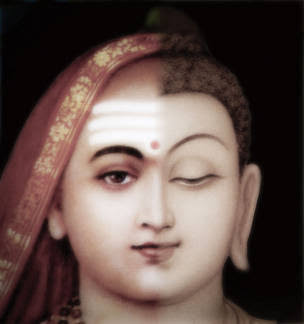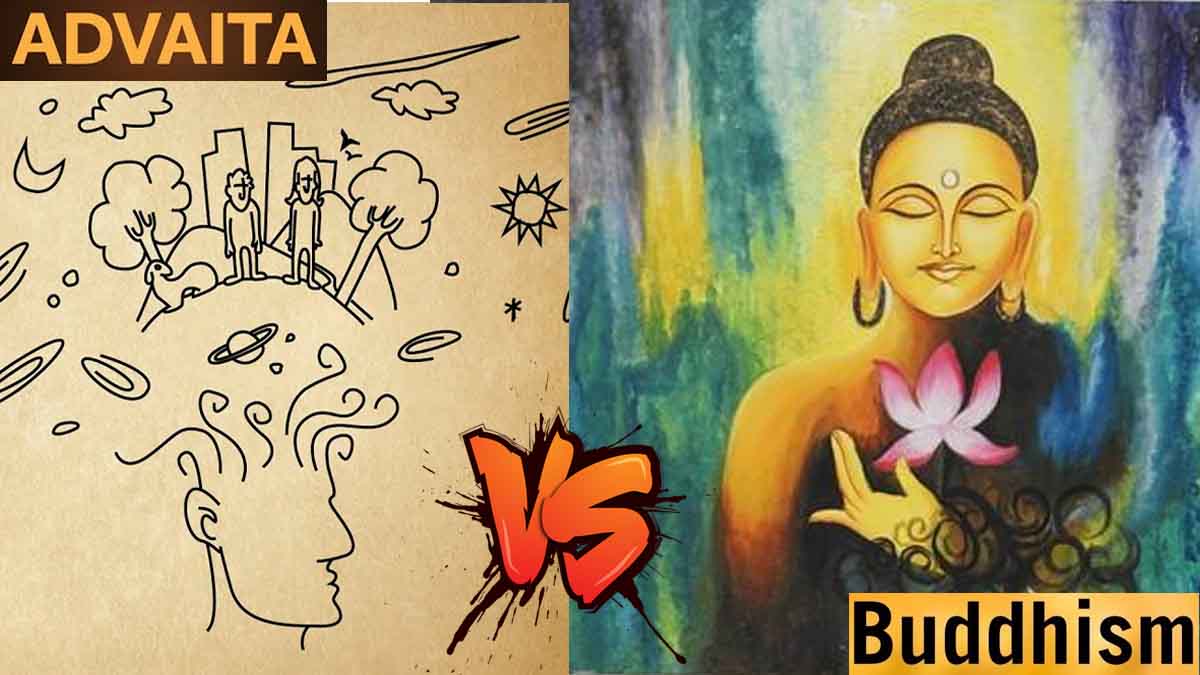“I was born a Hindu, however, it is not my fault…but I will not die a Hindu, for this is in my power.” – Dr Ambedkar told his audience in a speech at the Depressed Classes Conference in Yeola, Maharashtra on 13 October 1935.[1] Later in his life, he became a Buddhist along with his half-million followers.[2] In his time and even today, Buddhism is a minor religion with less than one percent followers in India.[3] However, in India, it was a major religion practised during the seventh century CE.[4] Interestingly, the prevailing picture of Buddhism started to fade out after the emergence of a prominent Hindu philosopher Adi Shankara or Samkara or Shankaracharya ( 788–820 CE ).[5] In any case, Shankara’s contribution to Hindus also contributed to the fall of Buddhists in India? In this essay, we will study and investigate Buddhism, Advaita philosophy and downfall reasons for Buddhism in a historical-comparative method.
BUDDHISM
“‘Are you God?’ they asked. ‘No.’ ‘An angel?’ ‘No.’ ‘A saint?’ ‘No.’ ‘Then what are you?’ Buddha (c.560–480 BCE) answered, ‘I am awake.’”[6] His name ‘Buddha’ retrieves its meaning from his answer using the Sanskrit origin budh denotes ‘wake up and to know’. Thus, Buddha means the “Enlightened One,” or the “Awakened One.”[7]
In Buddha’s time, the dominant religion was Brahminism now known as Hinduism and he tutored in the areas of the Ganges basin, north-east India.[8] Brahmanism administered by people called Brahmins who arrived the north-west of South Asia by around 1500 BCE.[9] The religion of Aryans or Brahmins was based on four Vedas( “a body of revealed oral teachings and hymns” ) and later compositions called Brahmanas or Upanishads.[10] Generally, some of them offer large, expensive and bloody sacrifices to their thirty-three gods known as devas.[11]
While social conditions were changing during the time of the Buddha, the Samanas who were the wandering philosophers rejected the Vedic tradition, cut off their family ties to think and debate.[12] Some say Buddhism was a part of Samana-movement.[13] One of his teachings, Buddha called Hindu Vedic scripts as ‘a foolish talk’, ‘a waterless desert’, ‘a pathless jungle’ and ‘perdition’.[14]
Huston Smith says, “authority, ritual, speculation, tradition, grace, and mystery – contributes importantly to religion, but equally each can clog its works.”[15] On the one hand, all these factors were dominated by the Brahmins and for others, Hinduism became irrelevant and felt they were in a trap.[16] On the other hand, Buddha preached against authority, ritual, skirted speculation, tradition, non-intense self-effort and supernatural.[17] He taught the fundamentals of the Four Noble Truths and the Eight-fold Noble path.[18]
ADVAITA
Shankara was a Malabar Brahmin who broke a Hindu tradition moving from brahmacharya to sannyasa and introduced celibacy pattern within Hinduism which was undoubtedly borrowed from Buddhism.[19] A firm defender of jnana (knowledge) as the only way for liberation, his form of commentary on the Vedantha Sutras known Advaita (non-dualism).[20] So far, his interpretation is the most accurate and earliest one and assumed to be the Vedanta.[21]
The Vedantins agreed that the world is the manifestation of Brahman, that knowledge of Brahman is the marga which leads to liberation, and that Brahman can be known only through the Shruti teachings of the Upanishads. They differed regarding the nature of Brahman, how Brahman causes the world to be, the nature of the world, the relation of the individual self to Brahman, and condition of the self in the liberated state.[22]
As Paul Gwynne describes, “Brahman is the one ultimate source of all truth and goodness, one fundamental ground of all existence, the origin and end of all things. It is even beyond personification and is better understood as an impersonal Absolute rather than a personal God as Christians presume.”[23] The essence of Advaita Vedanta, which is the famous saying of Adi Shankara: “Brahma satyam jagan-mithya; jivo brahmaiva naparah: Brahman is Real; the world is not Real; the individual soul is nondifferent from Brahman.”[24]
Shankara’s purpose was to express the truth, to furnish expression to ultimate reality.[25] There is an authentic line of spiritual descent from the original Shankaracharya down to the present day.[26] All five holders of these offices bear the title of Shankaracharya, and these Shankaracharyas have their official seats respectively at Badrinath (in the north), Puri (in the east), Dwarka (in the west), Kanchipuram (in the south), and Sringeri (also in the south). Each Shankaracharya also has the title of Jagadguru or “universal teacher” (jagad literally signifying “world”).[27] In India, two of the most widespread paths that lead to God: 1. “devotion” (bhakti) 2. the original Shankaracharya traditionally and symbolically represent the uncoloured light of knowledge or gnosis (jnana).[28]
On the one hand, through religious or moral merits and performing rituals or worship someone cannot be directed to the understanding of Brahman.[29] On the other hand, through intellectual effort someone cannot hope to reach the destiny, that is, through the collection of many intellectual data.[30] In Shankaracharya’s words, “with the realization of non-dual atman… having been devoid of the objects, as well as of the subject who could use them, the means of valid knowledge cannot exist either.” [31] In other words, “the higher Brahman in Advaita can be defined both cataphatically as a positive liberation (moksa) and apophatically through a negation of the false, illusory world of avidya.”[32]
REASONS FOR BUDDHISM’S DECLINE
Though Buddhism as a religion has a strong world presence, most importantly, originated from India, it has no effective presence in India.[33] Daniel Ingalls claims that there are clear anti-Buddhists arguments by Shankara’s commentary on Brahma-sutra or Vedanta-sutra.[34] The Brahma-sutra’s anti-Buddhism section comprises of fifteen sentences (Shankara enumerates it from II.ii.18 to II.ii.32).[35] Mainly, five well-known doctrines of Buddhism were attacked by Shankara: “the doctrine of the aggregates, the chain of causation, the doctrine of momentariness, the Buddhist definition of space (akasa), and the theory that origin comes only from destruction.” [36]
Regarding the doctrine of the aggregates, in Buddhist realism, atomic particles are placed side by side within all entities.[37] There are numerous number of sorts on these particles and classified in either two or five aggregates (samudaya or skandha).[38] These aggregates classified into two: material and mental.[39] However, Shankara argued against it by stating that “aggregates are impossible, for there is no conscious agent to cause their aggregation. Or, supposing that they did exist, being wholly independent, there would be no reason for them ever to cease.”[40]
Though Buddha is a heretic religion founder for Hindus, in some Hindu sacred texts such as Dashavataracarita of Kshemendra (eleventh century CE ) and Gitagovinda of Jayadeva (twelfth century CE), Buddha is portrayed as an avatar of Vishnu.[41] But this idea was to begin to spread during the middle of sixth century CE.[42] Somehow, Hinduism started to accommodate or engulf other religions through their ancient stories or puranas.[43] According to Basham, the different avatars of Vishnu absorbed regional gods and converted them into objects of ardent piety.[44]
The second President of India S. Radhakrishnan insists that Buddhism only presents a new viewpoint, but it is not an original doctrine.[45] Also, he points out a common theme in Buddhism and Hinduism such as caste-rejection and anatma-vada to support his claim.[46] He further argues that Buddha attempted to reduce the gap between theory and practice present in the corrupted version of the Upanishads and Brahminism which angered Hindus.[47] Though he was making this statement on behalf of Hindus, unlike Radhakrishnan, Ambedkar bolstered the radical difference between Buddhism and Hinduism.[48] Raghuramaraju presumes that “Shankaracharya who came after the seventh century can be ‘credited only with having emphasized this idea and thereby led to the fusion of the two Philosophies or Religions.’”[49]
According to D.D. Kosambi, at the end of the seventh century, the doctrine of Ahimsa universally accepted and abandoned Vedic sacrifices.[50] However, when it comes to farmers Buddhism as a religion cannot accept everything associated with their life.[51] For instance, Brahmin had a good working calendar which could stimulate the production by predicting the times of ploughing, sowing and harvesting.[52] Cultivators, tribesmen and peasants heavily relied on rituals but unlike Brahmins, Buddhist Monks were forbidden to practice.[53]
Gail Omvedt points out that the Muslim invasion sacked many great Buddhist institutions such as Nalanda’s university monasteries.[54] Ambedkar accepted the ‘Sword of Islam’ thesis and says, “Brahminism beaten and battered by the Muslim invaders could look to the rulers for support and sustenance and get it. Buddhism beaten and battered by the Muslim invaders had no such hope… The sword of Islam fell heavily upon the priestly class. It perished or it fled outside India. Nobody remained to keep the flame of Buddhism burning.”[55]
CONCLUSION
Buddhism was originated in India, but its once-mighty presence is missing in the sub-continent. Though it rose to provide justice to release people of Indian Sub-Continent from Brahminism or Brahmins and spiritual liberation. In one stage, the goal was attained by Buddhists, at the same moment, it started to slide from the doctrines of Shankara and his lineage of disciples, its unadaptable nature to a multi-cultural society and political changes such as Moghul dynasty. Thus, Buddhism’s decline not caused by only Advaita. In a Christian perspective, religion often forgets its purpose to serve people instead of serving themselves as we can link ourselves with a story such as Protestant Reformation. I recall Joseph’s story from Genesis, it is not about happy or sad circumstances, but it is about keeping the integrity.
[1] Arundhati Roy, The Doctor and the Saint: The Ambedkar–Gandhi Debate: Caste, Race, and Annihilation of Caste, 1 edition (Penguin, 2019), 52.
[2] Roy, The Doctor and the Saint, 139.
[3] “Census of India: Religion,” accessed July 24, 2019, http://censusindia.gov.in/Census_And_You/religion.aspx; Krishna Murthy Ponnapalli and Faujdar Ram, “Religious Taxonomy of States and Districts in India: An Analysis Using a Standardized Index of Diversity (SID) of Religion,” n.d., 26.
[4] Paul Gwynne, World Religions in Practice: A Comparative Introduction, 2 edition (Hoboken, NJ: Wiley, 2017), 307.
[5] Gail Omvedt, Buddhism in India: Challenging Brahmanism and Caste, 1 edition (Sage India, 2013), 160.
[6] Huston Smith, The World’s Religions, Anniversary edition (New York, NY: HarperOne, 2009), 82; Gwynne, World Religions in Practice, 6.
[7] Huston Smith, The World’s Religions, Anniversary edition (New York, NY: HarperOne, 2009), 82.
[8] Peter Harvey, An Introduction to Buddhism: Teachings, History and Practices, 1 edition edition (Cambridge England ; New York: Cambridge University Press, 1990), 9.
[9] Harvey, 10.
[10] Harvey, 10.
[11] Harvey, 10.
[12] Harvey, 12.
[13] Harvey, 13.
[14] D.N. Jha, “Brahmanical Intolerance in Early India,” Social Scientist 44, no. 5/6 (2016), 7.
[15] Smith, The World’s Religions, 93.
[16] Smith, 93.
[17] Smith, 94-97.
[18] Troy Wilson Organ, Hinduism: Its Historical Developments (Barron’s Educational Series, Inc., 1974), 142.
[19] Organ, 242.
[20] Organ, 242.
[21] Organ, 242.
[22] Organ, 242.
[23] Gwynne, World Religions in Practice, 30.
[24] Harry Oldmeadow, ed., Crossing Religious Frontiers: Studies in Comparative Religion (Bloomington, Ind: World Wisdom, 2010), 132.
[25] Oldmeadow, 194.
[26] Oldmeadow, 194.
[27] Oldmeadow, 194.
[28] Oldmeadow, 194.
[29] Natalia Isayeva, Shankara and Indian Philosophy, First Paperback Edition edition (Albany, NY: SUNY Press, 1992), 115.
[30] Isayeva, 115.
[31] Isayeva, 115.
[32] Isayeva, 64.
[33] Gail Omvedt, Ambedkar: Towards an Enlightened India (Penguin Random House India, 2017), 146.
[34] Daniel H. H. Ingalls, “Śaṁkara’s Arguments against the Buddhists,” Philosophy East and West 3, no. 4 (1954): 295, https://doi.org/10.2307/1397287.
[35] Ingalls, 295.
[36] Ingalls, 295.
[37] Ingalls, 295.
[38] Ingalls, 295.
[39] Ingalls, 295.
[40] Ingalls, 295.
[41] D.N. Jha, “Brahmanical Intolerance in Early India,” Social Scientist 44, no. 5/6 (2016): 3.
[42] Jha, 3.
[43] A. L. Basham, The Wonder That Was India (Grove Press, 1959), 334.
[44] Basham, The Wonder That Was India, 334.
[45] A. RAGHURAMARAJU, “BUDDHISM IN INDIAN PHILOSOPHY,” India International Centre Quarterly 40, no. 3/4 (2013): 72.
[46] RAGHURAMARAJU, 72.
[47] RAGHURAMARAJU, 72.
[48] RAGHURAMARAJU, 72.
[49] RAGHURAMARAJU, 72.
[50] Omvedt, Buddhism in India, 161.
[51] Omvedt, 161.
[52] Omvedt, 161.
[53] Omvedt, 161.
[54] Omvedt, 162.
[55] Omvedt, 162.

